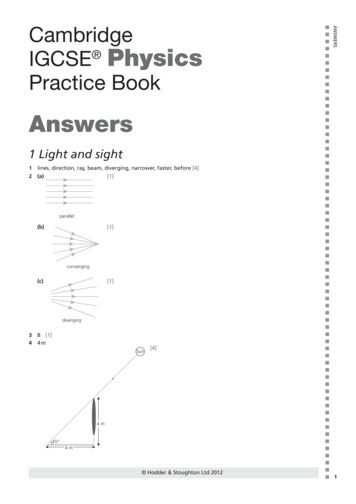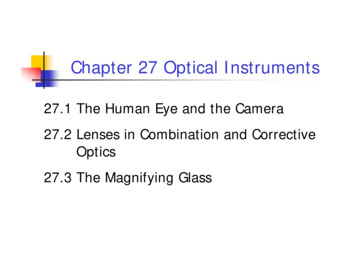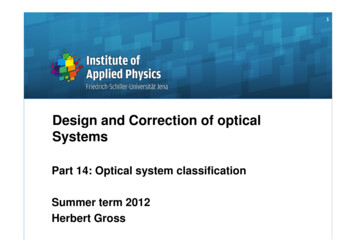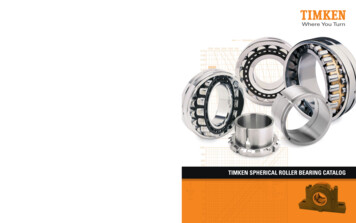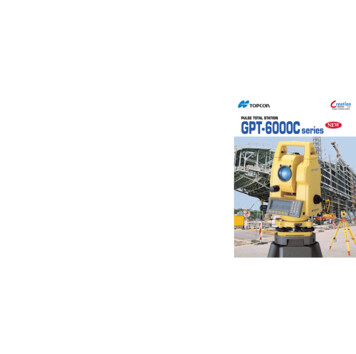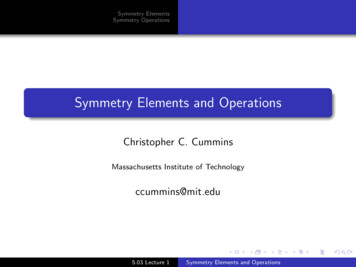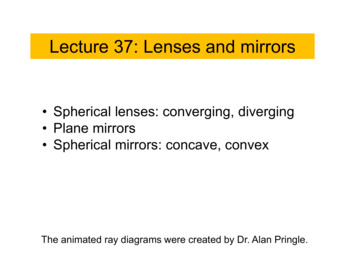
Transcription
Lecture 37: Lenses and mirrors Spherical lenses: converging, diverging Plane mirrors Spherical mirrors: concave, convexThe animated ray diagrams were created by Dr. Alan Pringle.
Terms and sign conventions for lenses and mirrors object distance s, positive image distance s’ , positive if image is on side of outgoing light, i.e. same side of mirror,opposite side of lens: real image s’ negative if image is on same side of lens/behind mirror: virtual image focal length fpositive for concave mirror and converging lensnegative for convex mirror and diverging lens object height h, positive image height h’positive if the image is uprightnegative if image is inverted magnification m h’/h , positive if upright, negative if inverted
Lens equation1 1 1 𝑠 𝑠′ 𝑓𝑠′𝑓𝑠 𝑠 𝑓𝑠 ′ ℎ′𝑚 𝑠ℎmagnification
Converginganddiverging lensesffFRays refract towards optical axisthicker in thecenterFRays refract away from optical axisthinner in thecenter there are focal points on both sides of each lens focal length f on both sides is the same
Ray diagram for converging lensRay 1 is parallel to the axis and refracts through F.Ray 2 passes through F’ before refracting parallel to the axis.Ray 3 passes straight through the center of the lens.FOF’object between f and 2f: image is real, inverted, enlargedobject outside of 2f: image is real, inverted, reducedobject inside of f: image is virtual, upright, enlargedI
Ray diagram for diverging lensRay 1 is parallel to the axis and refracts as if from F.Ray 2 heads towards F’ before refracting parallel to the axis.Ray 3 passes straight through the center of the lens.OFIF’image is always virtual, upright and reduced
Plane mirror point object A,source of light A’ is image of Aimage appears to be located behind the mirror image is reflected rays appear to come from A’ virtual
Image of an extended object every point of the object acts as light sourceevery point has an imagecollection of image points form image of the objectimage is upright, virtual, same size as object (h’ h), s’ s
Spherical mirror made from (polished) sections cut froma spherical surface center of curvature C is center oforiginal sphere vertex V is center of mirror segment radius of curvature R is radius ofsphere, or the distance from V to C.Principal Axis principal axis (or optical axis) is linepassing through C and VRCV
Rays parallel to the axis get reflected through a common pointthe focal point or focus F.Focal length f is distance from V to F.fCFV
Concave and convex mirrorconcaveFconvex
Ray diagramsRay 1 is parallel to the axisand reflects through F.Ray 2 passes through Fbefore reflecting parallel tothe axis.CFRay 3 passes throughC and reflects back onitself.Ray 4 goes to the vertex V and reflects under the sameangle below the optical axisV
Ray Diagrams for Concave Mirrors image is formed where the outgoing rays cross two principal rays are sufficient to find image,use third and fourth to check your diagramExample: object outside center (s 2f) image is real, inverted,and smaller than object(“telescope”) object between f and 2f image is real, inverted,and larger than object(“microscope”)CFReal image: outgoing rays do cross. Can be captured on screen or by camera.
object inside the focal point (s f) image is virtual, upright, and larger than object(makeup mirror)Ray 1: parallel to the axisthen through F.Ray 3: “through” C.CFRay 2: through F then parallel tothe axis.
Ray Diagrams for Convex MirrorsRay 1: parallel to the axisthen from F.Ray 2: Vertex.Ray 3: from C.Ray 4: towards F,then parallel. image is virtual, upright, and smallerthan objectFC
Concave mirrors:Shaving and makeup mirrorsSolar cookersSatellite dishes (for EM waves)Convex mirrors:Passenger side rear-view mirrorsAnti-shoplifting (surveillance) mirrorsChristmas tree ornaments
Image formation for mirrors and lensesTypeFocallength fObjectdistance sImagedistance nglensf 0s 2ff s’ 2frealinvertedreducedf s 2fs’ 2frealinvertedenlargeds fs’ 0virtualuprightenlargeds 0s’ 0virtualuprightreducedConvexmirror/diverginglensf 0Do not memorize! We can easily get this from the equation!
positive if image is on side of outgoing light, i.e. same side of mirror, opposite side of lens: real image s' negative if image is on same side of lens/behind mirror: virtual image focal length f positive for concave mirror and converging lens negative for convex mirror and diverging lens object height h, positive
